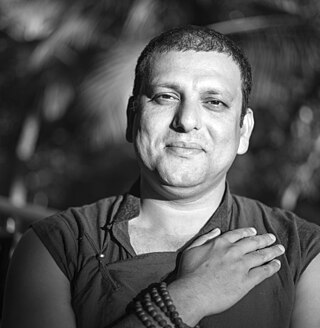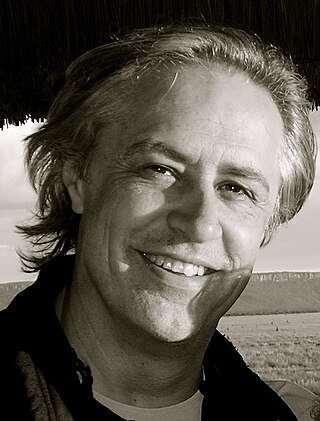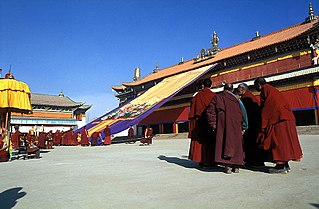Related Research Articles

Bodh Gayā is a religious site and place of pilgrimage associated with the Mahabodhi Temple Complex in Gaya district in the Indian state of Bihar. It is famous as it is the place where Gautama Buddha is said to have attained Enlightenment under what became known as the Bodhi Tree. Since antiquity, Bodh Gaya has remained the object of pilgrimage and veneration both for Hindus and Buddhists. In particular, archaeological finds including sculptures show that the site was in use by Buddhists since the Mauryan period.

Hannah Nydahl (1946–2007), wife of Lama Ole Nydahl, was an important Danish teacher and translator in the Karma Kagyu lineage of Tibetan Buddhism.

The Rimé movement is a movement or tendency in Tibetan Buddhism which promotes non-sectarianism and universalism. Teachers from all branches of Tibetan Buddhism – Sakya, Kagyu, Nyingma, Jonang, Gelug, and Bon – have been involved in the promoting Rimé ideals.
The Dorje Shugden controversy is a controversy over Dorje Shugden, also known as Dolgyal, whom some consider to be one of several protectors of the Gelug school, the school of Tibetan Buddhism to which the Dalai Lamas belong. Dorje Shugden has become the symbolic focal point of a conflict over the "purity" of the Gelug school and the inclusion of non-Gelug teachings, especially Nyingma ones.

Sogyal Rinpoche was a Tibetan Dzogchen lama. He was recognized as the incarnation of a Tibetan master and visionary saint of the 19th century, Tertön Sogyal Lerab Lingpa. Sogyal Rinpoche was the founder and former spiritual director of Rigpa — an international network of over 100 Buddhist centres and groups in 23 countries around the world — and the author of the best-selling book The Tibetan Book of Living and Dying, which has been printed in 30 languages and 56 countries. Before his retirement, in the wake of abuse allegations in 2017, he had been teaching for 40 years in Europe, America, Asia and Australia.

Ngawang Lobzang Thupstan Chognor, commonly known as 19th Kushok Bakula Rinpoche was a Buddhist lama, who also served as India's ambassador to Mongolia. He is mainly known for his efforts in reviving Buddhism in Mongolia and Russia by linking them with the community of Tibetan exiles in India.

Tenzin Priyadarshi is the president and CEO of the Dalai Lama Center for Ethics and Transformative Values at the Massachusetts Institute of Technology.

The 14th Dalai Lama, and known to the Tibetan people as Gyalwa Rinpoche, is the current Dalai Lama, also the highest spiritual leader and head of Tibet. He is considered a living Bodhisattva; specifically, an emanation of Avalokiteśvara in Sanskrit and Chenrezig in Tibetan. He is also the leader and a monk of the Gelug school, the newest school of Tibetan Buddhism, formally headed by the Ganden Tripa. The central government of Tibet, the Ganden Phodrang, invested the Dalai Lama with temporal duties until his exile in 1959.

Drongtse Monastery is a Tibetan Buddhist monastery was formerly one of the most important Gelug monasteries in Tsang, Tibet. There was also a chorten there.

Dana Sawyer is a full-time professor of religion and philosophy at the Maine College of Art & Design and an adjunct professor in Asian Religions at the Chaplaincy Institute of Maine. He is the author of numerous published papers and books, including Aldous Huxley: A Biography, which Laura Huxley described as, "Out of all the biographies written about Aldous, this is the only one he would have actually liked." In 2014, Sawyer's authorized biography of Huston Smith was published.

Tabo Monastery is located in the Tabo village of Spiti Valley, Himachal Pradesh, northern India. It was founded in 996 CE in the Tibetan year of the Fire Ape by the Tibetan Buddhist lotsawa (translator) Rinchen Zangpo, on behalf of the king of western Himalayan Kingdom of Guge, Yeshe-Ö. Tabo is noted for being the oldest continuously operating Buddhist enclave in both India and the Himalayas. A large number of frescoes displayed on its walls depict tales from the Buddhist pantheon. There are many priceless collections of thankas, manuscripts, well-preserved statues, frescos and extensive murals which cover almost every wall. The monastery is in need of refurbishing as the wooden structures are aging and the thanka scroll paintings are fading. After the earthquake of 1975, the monastery was rebuilt, and in 1983 a new Du-kang or Assembly Hall was constructed. It is here that the 14th Dalai Lama held the Kalachakra ceremonies in 1983 and 1996. The monastery is protected by the Archaeological Survey of India (ASI) as a national historic treasure of India.

Shanti Stupa is a Buddhist white-domed Stupa (chorten) on a hilltop in Chanspa, Leh district, Ladakh, in north India. It was built in 1991 by Japanese Buddhist Bhikshu, Gyomyo Nakamura. The Shanti Stupa holds the relics of the Buddha at its base, enshrined by the 14th Dalai Lama. The Stupa has become a tourist attraction not only due to its religious significance but also due to its location which provides panoramic views of the surrounding landscape.

Rato Dratsang, also known as Rato Monastery, Rato Dratsang is a Tibetan Buddhist monastery of the Gelug or "Yellow Hat" order. For many centuries, Rato Dratsang was an important monastic center of Buddhist studies in Central Tibet.
There is a small Mongolian community in India, comprising mostly Buddhist monks and scholars as well as international students from Mongolia.

Kirti Gompa, is a Tibetan Buddhist monastery founded in 1472 and located in Ngawa, Sichuan province, in China, but traditionally part of Amdo region. Numerous other associated Kirti monasteries and nunneries are located nearby. As of March 2011, the Kirti Gompa was said to house 2,500 monks. Between 2008 and 2011, mass arrests and patriotic re-education programs by Chinese authorities have targeted the monks, reducing the population substantially to 600 monks. The wave of Tibetan self-immolations began at Kirti Gompa.

Kushinagar International Airport is an international airport serving Kushinagar, Uttar Pradesh, India. In August 2021, the airport was licensed to operate as a customs notified airport, facilitating the movement of international passengers and Buddhist pilgrims. As of April 2023, the airport handles only domestic operations.

On 7 July 2013 a series of ten bombs exploded in and around the Mahabodhi Temple complex, a UNESCO World Heritage Site in Bodh Gaya, India. Five people, including two Buddhist monks, were injured by the blasts. Three other devices were defused by bomb-disposal squads at a number of locations in Gaya.

The Tatsag or Tatsak lineage is a Tibetan Buddhist reincarnation lineage whose first member was Baso Chokyi Gyaltsen (1402–73). Since 1794 the Tatsag has been the owner of the Kundeling Monastery in Lhasa. There has been some controversy over the representative of the lineage in recent years.

Tibet–India relations are said to have begun during the spread of Buddhism to Tibet from India during the 7th and 8th centuries AD. In 1959, the Dalai Lama fled to India after the failed 1959 Tibetan uprising. Since then, Tibetans-in-exile have been given asylum in India, with the Indian government accommodating them into 45 residential settlements across 10 states in the country. From around 150,000 Tibetan refugees in 2011, the number fell to 85,000 in 2018, according to government data. Many Tibetans are now leaving India to go back to Tibet and other countries such as United States or Germany. The Government of India, soon after India's independence in 1947, treated Tibet as a de facto independent country. However, more recently India's policy on Tibet has been mindful of Chinese sensibilities, and has recognized Tibet as a part of China.

The "Global Buddhist Summit" is a conference attended by Buddhist monks from several nations. The conference is attended by scholars, leaders of the Sangha, and practitioners of the Dharma from around the world.
References
- ↑ "First International Buddhist Confederation held in Delhi". 9 September 2013. Retrieved 20 December 2014.
- ↑ "International Buddhist Confederation 2013" . Retrieved 20 December 2014.
- ↑ "India to host new world Buddhist body". 1 December 2011. Retrieved 20 December 2014.
- ↑ "Venerable Lama Lobzang, the visionary of the International Buddhist Confederation". 18 June 2013. Archived from the original on 11 April 2014. Retrieved 20 December 2014.